The Anatomy of a Perfect Blog Post for SEO Success in 2024
Uff, it can be hectic to write a perfect Blog that is also well-optimized. People thought it was Rocket science, but NO!
Table of Contents
ToggleYour copy should engage with your experiences and be Snappy! You have to hook your readers with your unique viewpoint. But you also need technical optimization to rank on search engines.
I can understand that feeling when you give 100% Effort to make your content outstanding and hit the publish button; after that…crickets? No traffic, no engagement, no love from search engines or users. This feeling is like being the kid left out on the playground and others to have fun from the corner.
Now! My friend, it’s time to ditch those playground blues and learn how to create blog posts that are loved by search engines and readers.
After AI entered the world, the game of SEO changed, and AI is ready to steal every task. But to beat AI, you need to stay ahead to ensure your content doesn’t get left behind.
Suppose you write an article and click the publish button. Within a few days, your post will rank on the first page of Google and drive targeted traffic to your site.
Your readers can’t get enough, sharing your content like wildfire and leaving comments that make you blush.
Sounds too good! Well, Be Ready! Here I Will discuss the anatomy of a perfect blog post that’ll force Google to rank your content.
In this blogpost I will share that From creating irresistible headlines to optimizing your content voice search and beyond, It will not only help you to attract the targeted audience but also dominate the search engine rankings.
So, grab a pen (or your favorite note-taking app), Sit comfortably, and get ready to be a Master of writing a Blog Post in 2024.
By the time we’re done, you’ll have more knowledge and skills to turn your blog into a magnet to attract traffic, engagement-boosting, and SEO-slaying.
Let’s dive in and Find the anatomy of a perfect blog post that’ll have your competitors green with envy! Let’s Get Start….
Let’s Write the perfect blog posts to rank #1 in 2024.
You May also like: How to do Content Gap Analysis: The Complete Guide
Step 1: Find a Topic That Converts and Ranks
Everything starts with the right topic. For SEO, you want keywords that users want with a good search volume. it will be more yummy if it has commercial or transactional intent. Do Keyword Research Properly.
Initially go for a topic that is easy to rank and find the problem that your audience is facing, it could be small or big, Depends! So choose wisely.
You should go for Long-tail keywords with low KD and average search volume.
You can use the KGR technique for it.
KGR = (Number of Search Results with Keyword in Title) / (Monthly Search Volume)
According to Mangools, a Keyword Golden Ratio (KGR) of less than 0.25 indicates that a page should rank in the top 50 as soon as it’s indexed.
Before that Ask yourself:-
What terms do my potential customers search when looking for solutions online?
What topics get steady search volume but low competition?
What “how-to” questions could I uniquely answer?
What keywords align with the products or services I offer?
What trends or developments in my industry need explanation?
What common pain points of targeted audiences can I address?
Brainstorm ideas, then validate demand and competitiveness through keyword research tools like Ahrefs, Semrush, or Google Keyword Planner.
Step 2: Optimize Around a Primary Keyword
Once you have a winning topic, find the primary keyword you want to target and rank for.
Your target Keywords will shape content structure and focus. Have 2-3 secondary keywords to intersperse as well.
Research questions from PAA and SEmrush. Find Long-tail variants that expand on your primary keyword for additional optimization.
With the help of this, you can instruct search engines about your content focus, and this will increase the chances of your post appearing in relevant search queries.
Assume that you run a travel blog and want to create a post about the “8 Best Places to Visit in USA.” Your primary keyword could be “Best Places to Visit in USA.”
Your title and headline should include your primary keyword. For example, “8 Best Places to Visit in USA (Last one is my favorite).”
In your introduction, you can naturally add your primary keyword within 200 words and provide a brief overview of what the post will cover.
Throughout your post, strategically include your targeted keyword and LSI keywords in your subheadings and content. For example-
“Places to Visit in the USA”
“Most Recommended places to visit in USA”
“Popular Places to Visit in the USA”
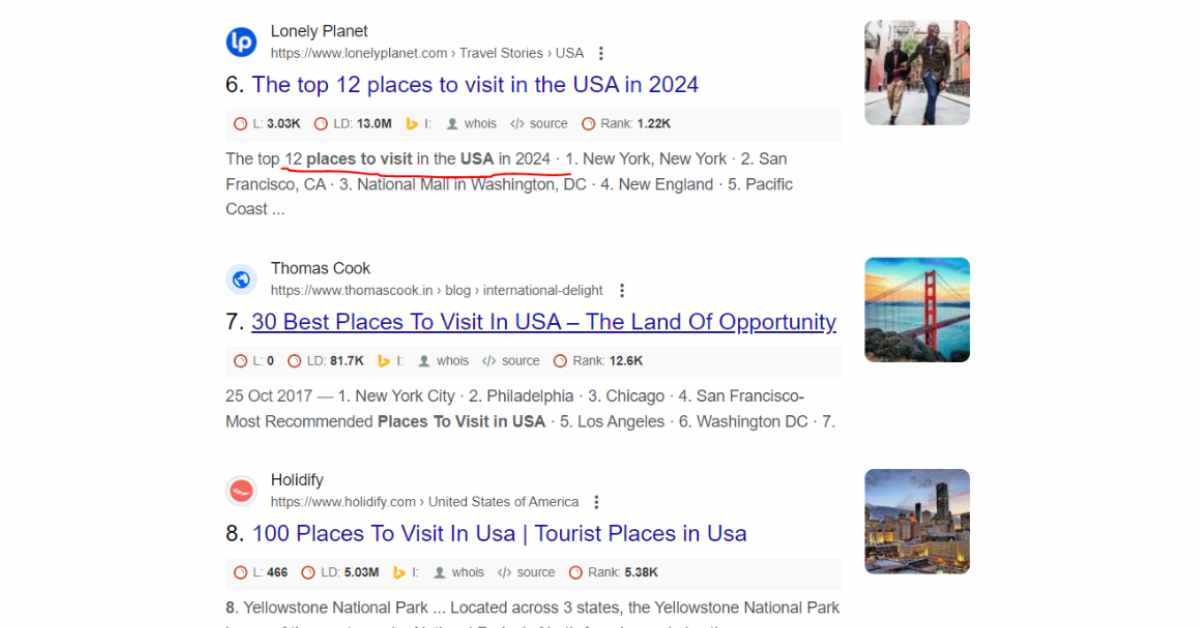
Optimizing your content around your targeted keyword will increase the chances of your post ranking on top for that keyword and relevant search queries.
However, it’s important to maintain a balance and not overoptimize. Avoid keyword stuffing, as this can negatively impact user experience and hurt your search engine rankings.
According to Backlinko’s analysis of 11.8 million Google search results, pages ranking in the top 3 positions included the target keyword in the title 33% of the time.
You May also like: 15+ Best Etsy SEO Tools (Free & Paid)
Step 3: Create an SEO-Focused Headline
Your headline is the first impression to the user and can make or break the CTR
Follow these principles like:-
- Add your primary keyword organically in Headline (no fluff)
- Keep it clear, concise, and easy to understand
- Headlines with numbers or listicles (e.g., “10 Best…”) mostly perform well
- Using powerful words like “Best,” “unbelievable,” “amazing,” “secret,” or “proven” can add emotional impact.
- Speak directly to your audience’s needs (in a conversational tone)
- Keep headlines under 60- 65 characters (with brand name)
- Go for emojis and brackets for social media shares
- Make your headline informative and customer-focused, which has the power to hook readers.
You can use these Free resources to choose the BEST Title for your Blog-
- CoSchedule Headline Analyzer
- AmIWorkingWell Headline Analyzer
- All-in-one SEO headline analyzer
- Sharethrough Headline Analyzer
- Monster Insights Headline Analyzer
- Tweak Your Biz Title Generator
Step 5: Provide Value Through Well-Written Content
Now, the outline is ready, and you must bring life to it!
This is where you’ll transform those bullet points into engaging, valuable content that engages, educates, and satisfies your user’s cravings.
people don’t love to READ, They Love to SKIM.
Break your content into scannable paragraphs for each section, and do it strategically. Your Content should be well-written and according to the user’s needs.
According to a study by Nielsen Norman Group, users typically read 20–28% of the text on a webpage during an average visit.
Breaking your content into short, scannable points makes it easier for readers to consume and digest the information. For example-
- [Short 2-3 sentence paragraph]
- [Another short paragraph]
- Use transition words to connect concepts
- Transition words help create a logical flow and structure in your writing.
A research paper published in the Journal of Technical Writing and Communication found that using transition words improved reader comprehension by 28%.
Some Common Transitional Words are- consequently, therefore, accordingly, as a result, because, for this reason, hence, thus etc.
Here’s an example using “therefore”-
SEO is not a one-time job, it’s a long-term investment and, most important, for driving organic traffic to your website. Therefore, optimizing your content for search engines and focusing on user intent should be a top priority.
Include relevant stats, facts, and links to credible sources
According to Forbes data, In 2024, a notable 90% of marketers using short-form videos plan to either boost or sustain their investment in this content type.
For example, you could include a statistic like-
“Voice search is rapidly Booming, with 71% of consumers preferring to use voice assistants over typing queries (Source: Neilsen Research).”
For this- Use bullets or numbered lists, and Lists make content easier to scan and digest.
For example, you could use a bulleted list to showcase the benefits of guest blogging-
- Reach a new audience
- Build backlinks to your site
- Establish yourself as an industry expert
- Add capsules of related content within sections
Throughout your post, include bite-sized capsules of additional value.
For instance, you could have a “Pro Tip” or “Case Study” section within a larger section of your post.
The content itself must be engaging, educate and satisfy readers.
You’ll keep readers hooked by giving value in an exciting, relatable way.
Focus on the user’s craving and make it high-quality.
Stick to delivering focused, actionable advice that truly helps your audience.
Follow these steps and examples, statistics, and best practices, and you’ll create a blog post that looks professional, reads engagingly, and provides real value to your readers through high-quality content.
Make your content engaging and satisfy your users. You’ll have content that truly resonates!
Step 6: Optimize for Your Focus Keywords
Your Draft is Done, now optimize content to target your primary and secondary keywords-
However, remember that keywords should enhance your content. Don’t stuff it inorganically. The priority is still delivering value to your readers.
Strategically include your keywords in the meta title, description, url and throughout the content
Your meta title is one of the first things users see in search results, so make sure to include your primary keyword there.
For example-
“The 15 Best Places to Visit in USA (Primary Keyword)”
Then, naturally, weave in your keywords a few times throughout the introduction, body, and in conclusion.
But don’t overdo it – shoot for a keyword density of around 1-2%.
Go for LSI Keywords and long-tail phrases naturally.
Use LSI and long-tail keywords to help your primary keyword to cover more search queries.
For example-
- “Popular places to must visit during winter” (Keyword Variant)
- “Top-rated places to visit in USA during Winter season” (Long-Tail Keyword)
Check that keywords appear in subheadings.
Subheadings provide structure and allow you to highlight keywords. For example-
- “Most Popular places to visit in USA during holidays (Primary Keyword)”
- “Best places to visit with kids but without luggage (Long-Tail Keyword)”
Use keywords in image file names and alt text
Optimize your images by including keywords in the file names (save your file with keyword) and alt text for better visibility.
Alt Text: “Best places to Visit in USA during Summer vacation”
File Name: best-places-to-visit-in-USA.jpg (I prefer Webp/AVIF Format)
Bold keyword instances that most relate to buying intent
When discussing products, services or topics with commercial intent, bolding focus keywords can boost visibility and click-through rates.
“If you’re looking to book your hotels and flights, we recommend…”
Add keywords fluently without over-optimizing
Most importantly, use keywords naturally and strategically without compromising the reading experience.
Keyword stuffing can lead to lower rankings and engagement, and we can learn from this from the latest Google Core update.
The goal is to help search engines understand your content while keeping it fluent and valuable for users.
By strategically optimizing for your focus keywords while prioritizing quality over quantity, you’ll create valuable content for users and rank well in search results- a win-win for user experience and SEO.
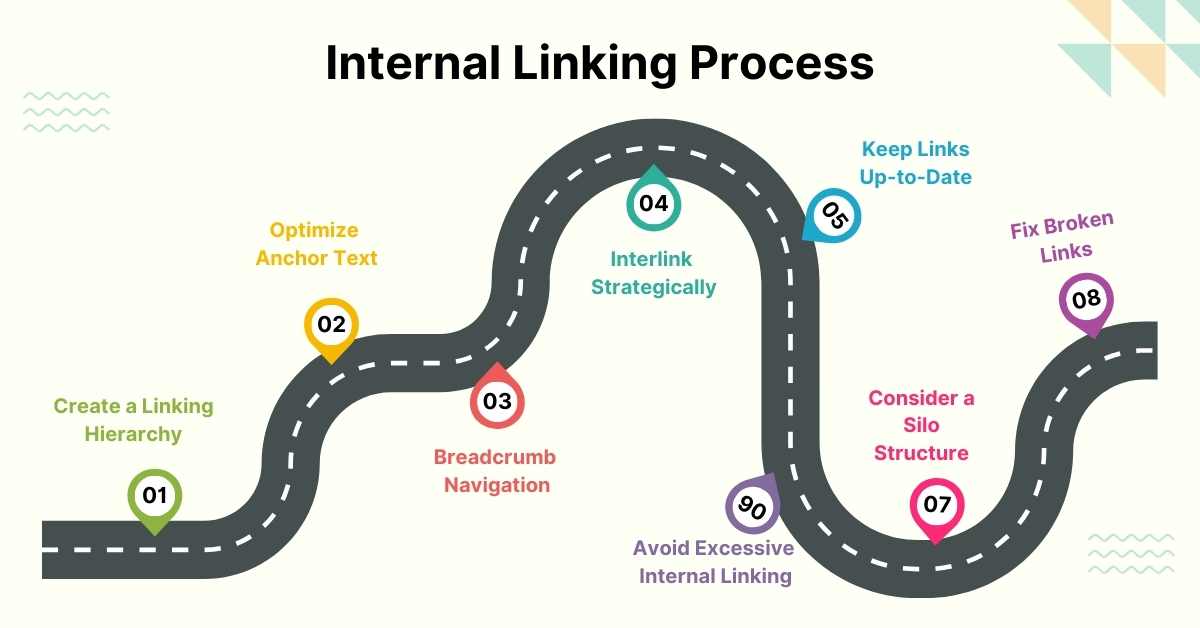
Step 7: Make a Strong Internal Link Network
Don’t be so mean and give links to relevant external sources, it will help readers to use valuable resources.
If you are creating In-depth, valuable content, supporting your points and claims with credible external sources is important.
This tiny move builds trust in your content and authority. It also encourages readers to explore additional resources
However, Make sure to create a strong internal linking network.
Relevant internal links guide users to read more, boost SEO efforts, and, most importantly, keep them engaged. With a strong internal linking structure, your website will be a user-friendly, SEO-friendly masterpiece!
This has two main purposes:-
It creates a better user experience by keeping readers engaged and spending more time on your site, where they can continue to consume your valuable content.
Here are some ways to prioritize internal linking-
- Start by Auditing your existing content and organizing it into logical categories or topic clusters. This helps you to connect the dots and make a strong net of linking.
- Link to High-Priority Pages- High-authority pages (like your homepage) link to relevant sub-pages, creating a link juice flow.
- Use descriptive and relevant anchor text for your internal links. Don’t just use generic text like “click here.” Instead, use relevant keywords or phrases.
- Look for natural opportunities within your content to link to relevant pages/posts on your site. This will guide users to read deeper information and keep them hooked until the end.
- Avoid Excessive Internal Linking, and for complex websites, organize content into thematic groups (silos) linked together by a central pillar page.
Remember, the key is to strike a balance- provide enough external links to support your points and give readers additional resources to read.
Still, your priority should be internal links to your high-quality and relevant content to keep users engaged.
Step 8: Include Creative Images, infographics and Charts
If your Blog has creative, engaging, and catchy visuals like infographics, images and videos then it will hold users for a long time.
You know that visuals are processed 60,000 times faster than text and according to the Social Science Research Network 65% of people are visual learners.
Videos and infographics are not only break up the text but also make content more digestible and engaging, ultimately more shares on social media.
Place relevant, high-quality Images
High-quality, relevant images will make your blog more engaging and catchy. Strategically place them in your post to complement the text and add visual interest.
Create simple branded charts or graphs
It will be more beneficial if your blog has included data or statistics. You can create simple, branded charts or graphs to visualize the information. (Use Adobe for free).
This small move makes the data more easily digestible and adds a professional touch to your content.
Use info boxes or panels to highlight key quotes
You can also quote the experts or include testimonials, which will build trust, credibility and authority to your content.
To make these quotes stand out, consider using info boxes or panels to highlight them.
Add embedded video for demos and tutorials
As you know most big brands also include step-by-step videos in their blog. You can also do it, with step-by-step instructions, demonstrations, or tutorials, but they should not be the same as your blog post.
High-quality videos will effectively explain complex concepts in a more engaging and visually appealing way.
Break up lengthy sections with appropriate memes
People Love Memes, they are trending and should be used appropriately. It can be a great way to break up lengthy text formats and add humor or relatability to your content.
Just be sure to use relevant and appropriate memes for your audience and the topic.
Caption each visual element to summarize key information
Try to include brief captions summarising key information or takeaways.
It helps strengthen the content for readers and makes your visuals more accessible and shareable on social media.
Make sure to strategically place your images, videos, and infographics to avoid cluttering your posts with too many components.
Your ultimate goal should be to enhance the overall reading experience, not overwhelm or distract from the main content.
Always prioritize quality over quantity so for this maintain a balance between your text and creatives.
Step 9: Format Content for On-Page SEO
Proper formatting of your content improves, how search engines understand and show your content to users. It also makes your posts easier for readers to scan and consume.
Here are some simple formatting tips-
Proper HTML formatting improves SEO page structure
Feature H2 subheadings for each section
Break up your content into sections using H2, and H3 Header tags. This creates a clear structure that search engines and readers can easily follow.
H2 Tags- For main subtopics or sections, use relevant keywords.
H3 Tags- For sub-subheadings under H2, further content breakdown.
The most recommended is to use H1, H2, and H3…H4 is only for skimming content like bullet points information.
The Rights structure is H1 (main heading)…H2..H3..H3..H2..H3..H3..H2
Mark keywords in bold that relate to buying intent
While sharing information about products or services, Write your relevant keywords in bold/uppercase letters to make them stand out.
Use bullet points or numbered lists
Lists make your content more scannable and easy to digest.
Example-
Best SEO Tools to use-
- SEMrush
- Rankmath
- Yoast SEO
- All in one SEO
- WP Rocket
Add hyperlinked call-to-action buttons
Place clickable buttons throughout your post to encourage desired actions like purchases or sign-ups.
Example-
<a href=”/hiking-gear” class=”btn”>Shop Hiking Gear</a>
Include breadcrumb navigation for guides
For long, in-depth guides, use breadcrumb links at the top to show the page’s hierarchy.
Moz states that breadcrumbs improve website navigation and signal content structure to search engines.
Use Table of Contents
In this fast-moving world, it’s important to use TOC for easy navigation. It improves the user experience by allowing readers to quickly jump to the sections.
Don’t forget to optimize your content for skimmers.
Search Engine Journal reports that tables of contents can reduce bounce rates by 25%.
By implementing these simple formatting techniques, you’ll create a better experience for both search engines and Users.
Step 10: Optimize Meta Data
Meta Data helps a lot to grab more traffic. So many SEO plugins like Rankmath, Yoast SEO, and All in One SEO are available for free. This SEO plugin helps you to optimize critical metadata elements.
Key areas it covers-
SEO Title Tag
- Example- “Best SEO Plugins for WordPress (2024 Review)”
- It Should be 60 characters or less with the target keyword
- It helps search engines understand what your page is about.
Meta Description
Example- “Boost rankings with these top SEO plugins for WordPress. A detailed review of Yoast, RankMath, All in One SEO, and more. Find the best fit for your needs.”
The sweet spot is around 160 characters summarizing the page (Approx. 152 characters on desktop and 105 characters on mobile).
Target Keyword
- Example- “best SEO plugin for wordpress”
- Yoast analyzes exact match keyword usage and prominence
- A clearly Mentioned focus keyword is important for rankings.
Image Alt Text
- Example- “Screenshot of Yoast SEO plugin interface”
- Alternative text for images using target keywords and save it with the title name
- According to UX Stack Exchange, 23.2% of home page images are missing alternative text.
Optimize Url
- Use short, keyword-rich URLs
- Include target keyword in URL slug
- Don’t use numbers/year in url
- use (- or |), not underscore
- Keep your URL around 75 characters
- Write URL in lowercase and use slashes
- Use Static URLs rather than dynamic
By optimizing metadata, the SEO plugin sends strong relevance signals to Google about each page’s content and purpose.
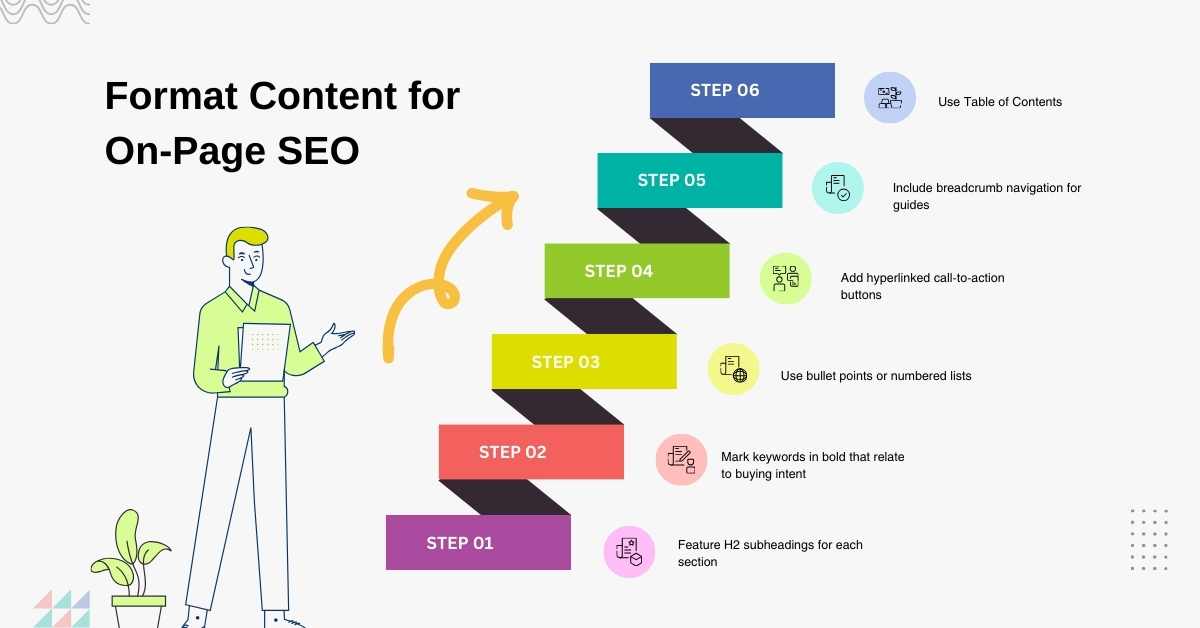
Step 11: Create Buzz and Promote
You’ve poured your heart and lungs (joking) to create valuable content. But without a solid promotion strategy, even the most brilliant post can go dark.
Promote your content with strategy-
Share on Social Media
Don’t just drop a link though– create threads highlighting key points and engaging visuals to spark discussion. Share in relevant community groups/spaces.
Email Newsletter Promotion
Have an email list? Send out a newsletter not just related the post, but storytelling around the topic and key takeaways to drive subscribers back to your website.
Influencer & Publication Outreach
Try to communicate with influencers in your niche to consider featuring or sharing your content with their audiences.
Similarly, relevant publications may want to republish summaries or snippets of your post if it offers value to their readership. Use Medium, Quora, and Reddit sites to promote your content.
Guest Posting & PR
Seek out guest posting opportunities on high-authority and relevant sites.
Internal Linking
Don’t forget your own website! Make a strong internal link network on your post and engage users for a long time.
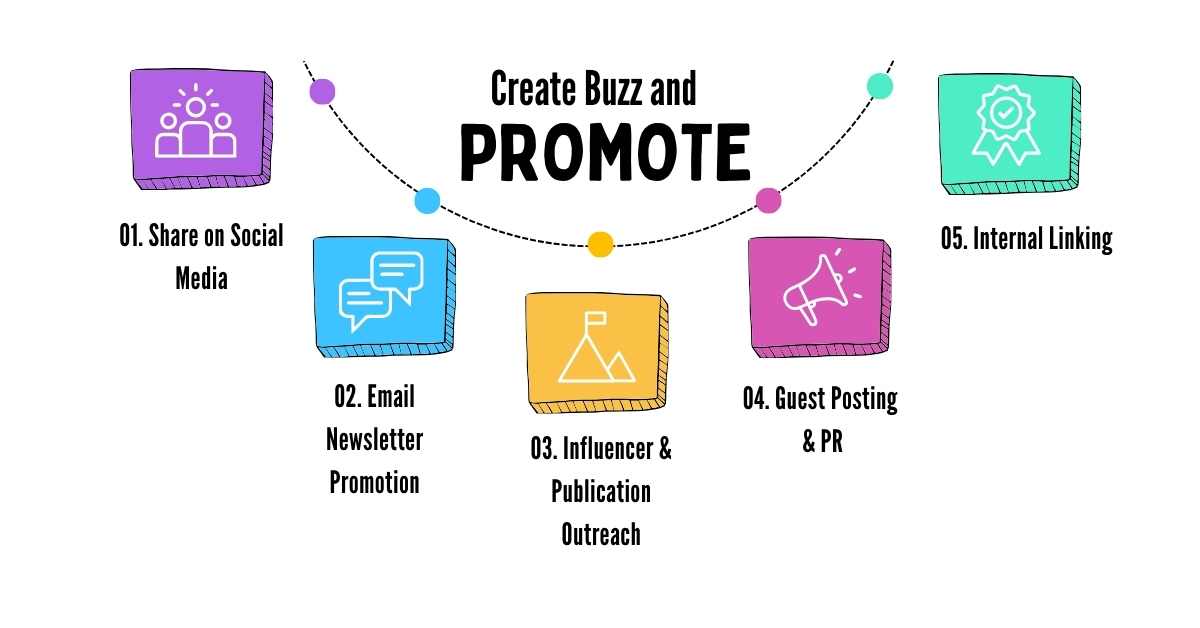
Step 12: Monitor Analytics
Now your content has been published after that analyze the data to find areas to improve your content as users want.
Key areas to review-
Google Analytics Traffic Sources
Example- You published a post about “Best Running Shoes for Flat Feet”
GA4 or GSC, you see the keywords from where most of the traffic is coming.
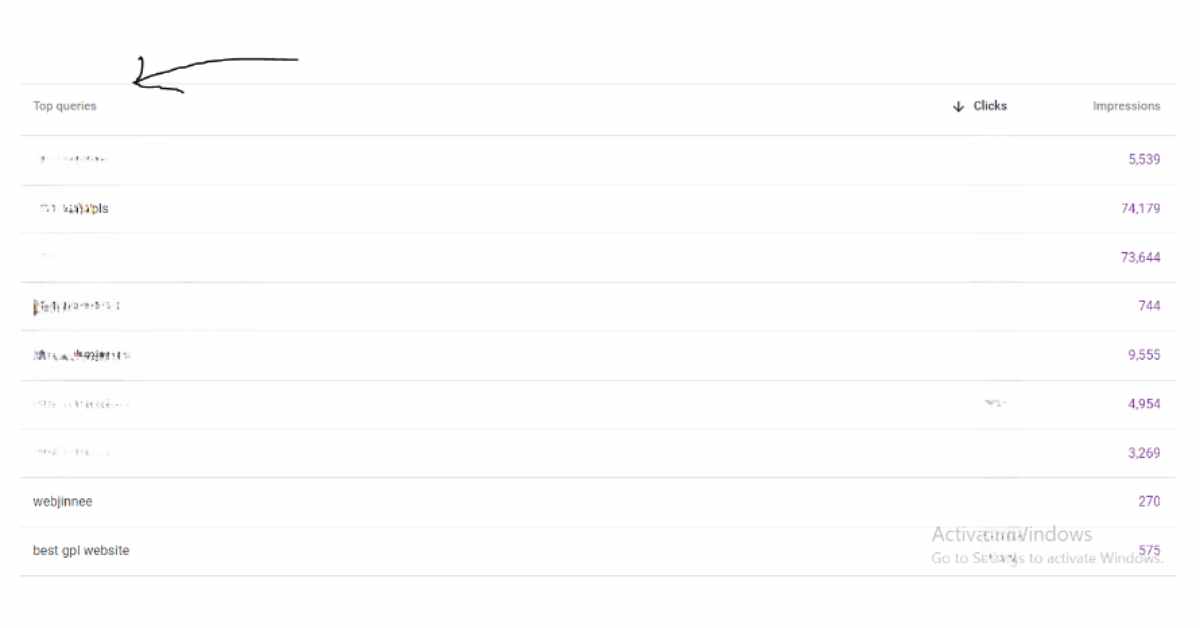
Search for keywords like:-
“running shoes for flat feet” (315 users)
“best-running shoes for flat feet” (227 users)
“flat feet running shoe reviews” (166 users)
This reveals the potential to optimize around these popular terms
Check Early Ranking Trends
Your Google Search Console data will give you direction to rank high. If you currently rank #5 in position, with 28% of impressions With some improvements, you may be able to crack the top 3.
Social Engagement Analysis
If you invested in social promotion, parse through which posts and creative resonated best. Which platforms really moved the needle in engagement and drove quality traffic?
Backlink Acquisition
Use a backlink monitoring tool to see if your content is earning early citations and links from authoritative sites.
Read User Comments and Queries
Pay attention to comments on your post or questions in relevant communities. Are there information gaps or areas of confusion highlighted by readers?
Split Test Titles and Meta Descriptions
Not getting enough clicks from search? Run a split test pitting different title tags and meta descriptions against each other. Then analyze CTR performance to guide a winning approach.
Voice search rapidly gaining popularity, what steps can you take to optimize your blog content for voice search queries?
The number of digital voice assistants is expected to reach a staggering 8.4 billion units worldwide by 2024.
With over 110 million virtual assistant users in the US alone, this market is poised for explosive growth, presenting immense potential for businesses and investors.
Here are some steps you can take to optimize your blog content for voice search queries-
- Use natural language and a conversational tone (talk to one but message for everyone)
- Focus on long-tail keywords and questions (queries)
- A study by Bright Local found that nearly 60% of voice search queries were in question form.
- Structure your content in a Q&A format (Add FAQ also for PAA)
- Use schema markup (It is a structured data format that helps search engines better understand the content on your website).
- Optimize for featured snippets Featured (We known as position zero results, are often read aloud by voice assistants when answering queries. You can add 50 words summary in the start of your content to rank for zero position).
- Keep your content up-to-date because yesterday’s news is old news in voice search land.
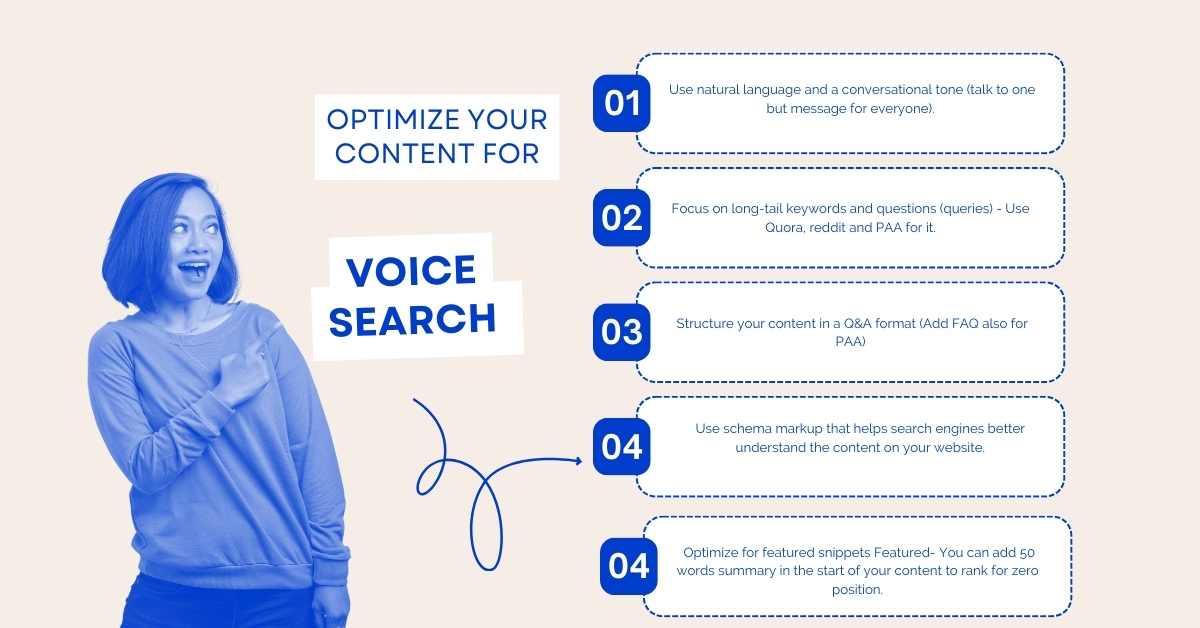
How can you structure your blog post content to improve readability and keep readers engaged?
According Microsoft study, the average human attention span has decreased to just 8 seconds, so it is important to present information in a scannable and digestible format.
Creating your content clearly and engagingly is Important for improving readability and keeping your readers hooked till the end.
Here are some simple tips to structure your blog posts:-
- Break your content into headings and subheadings
- Breaking up your content with descriptive headings (H1, H2, H3) helps readers to scan and they can read whatever they want.
- H1 Tag- One per page, represents the main topic, include target keyword.
- H2 Tags- For main subtopics or sections, use relevant keywords.
- H3 Tags- For sub-subheadings under H2, further content breakdown.
- Descriptive- Make headers accurately reflect the content’s topic.
- Length- Keep headers Clear, simple and around 60 characters for better SERP display.
- Structure- Use headers to break up content and improve readability.
- Accessibility- Proper heading structure aids screen readers and user experience.
- Internal Linking- Use header text for relevant internal links.
- Typically, aim for 3 to 5 h2 per page (if your content is not long form).
- You can use more than 5 H2 for Listicles articles.
- Most recommended is to use H1, H2 and H3…H4 is only for skimming content like bullet points information.
- The Rights structure is H1 (main heading)…H2..H3..H3..H2..H3..H3..H2
Include Keyword-
- Add your target keyword(s) in the H1 tag when possible
- Use relevant keywords or variations in H2 and H3 tags
- Avoid keyword stuffing, use keywords naturally within headers
- Create your H1 short and punchy.
How can you use internal linking within your blog posts to improve navigation and distribute link equity?
Foundation of Internal Linking
Anchor Text- clickable text, like a signpost, guides users to the right content but doesn’t use the same anchor text.
A natural anchor text profile should have a mix of branded, partial-match, URL, and natural anchors.
Link Juice– The authority passed on through links, spreading value across your site.
Relevance- Links connecting related pages, creating a smooth user experience.
Link to High-Priority Pages- Give Links to high-priority pages of your website that want to show to your users.
How to do it:-
Create a Linking Hierarchy- Think of your website structure as a pyramid. High-authority pages (like your homepage) link to relevant sub-pages, creating a flow of link juice.
Optimize Anchor Text- Use descriptive and relevant anchor text for your internal links. Don’t just use generic text like “click here.” Instead, use relevant keywords or phrases.
Breadcrumb Navigation- This is important for users to understand their current location within the site structure and it will open the door for more internal linking opportunities.
Interlink Strategically- Look for natural opportunities within your content to link to relevant pages on your site. This keeps users engaged and helps them find deeper information.
Keep Links Up-to-Date- When you increase the number of articles in your website, Make sure that your internal links remain up-to-date and relevant. It negatively impacts user experience.
Avoid Excessive Internal Linking- Don’t include too many irrelevant internal links! Too many internal links can dilute the link equity passed to each page and potentially be seen as a spammy tactic.
Fix Broken Links- Broken links can harm your overall SEO efforts. Audit your website regularly and fix broken links.
Consider a Silo Structure- For complex websites, organize content into thematic groups (silos) linked together by a central pillar page.
What are the most important On-Page SEO factors to consider when optimizing your blog posts?
Here are On-Page SEO Factors to consider-
Title Tags
- Title tags are 60 characters or less
- Target keyword appears early in the title tag
- Titles are unique for each page and describe the page’s focus
- Include your Brand name in title tag
Meta Descriptions
- Meta descriptions are 155 characters or less
- Description summarizes the page’s content
- Target keyword is included in the meta description
- Call-to-action and emotional hooks are used to entice clicks
Headings
- H1 contains the target keyword and clearly conveys the topic
- Subheadings use H2, H3 tags in descending order
- Headings summarize content sections in a logical hierarchy
Content
- content optimal length does not matter, it should be according to the user’s craving and provide value but at least write 1000 words.
- Keywords appear in the first 100 words of the main content
- Target keyword density is 1-3%
- Use LSI keywords to avoid Keyword stuffing
- Include target keyword in ALT text and filenames
- Include list posts with related keywords to expand optimization
- Optimize for Feature snippet
- Regularly update your content (minimum 2 times in a year)
URL Structure
- URL contains primary and secondary keywords
- Hyphens used to separate words in URL
- Avoid stop words, special characters or excessive words
- URL is consistent with site architecture
Page Speed
- All images and media compressed and lazy loaded
- Caching enabled and page size under 2MB
- Eliminate render-blocking resources
- Optimize code to reduce HTTP requests
Internal Linking
- Use keywords as anchor text for internal links
- Link to related content and high-authority pages
- Check for broken internal links regularly
External Links
- Link to high-quality sites with relevant content
- Use branded anchor text for external links
- Acquire backlinks from authority domains when possible
Add Catcy Images, Infographics, and videos
- Add videos, images, podcasts, etc. to increase engagement
- Optimize your images with proper Alt text.
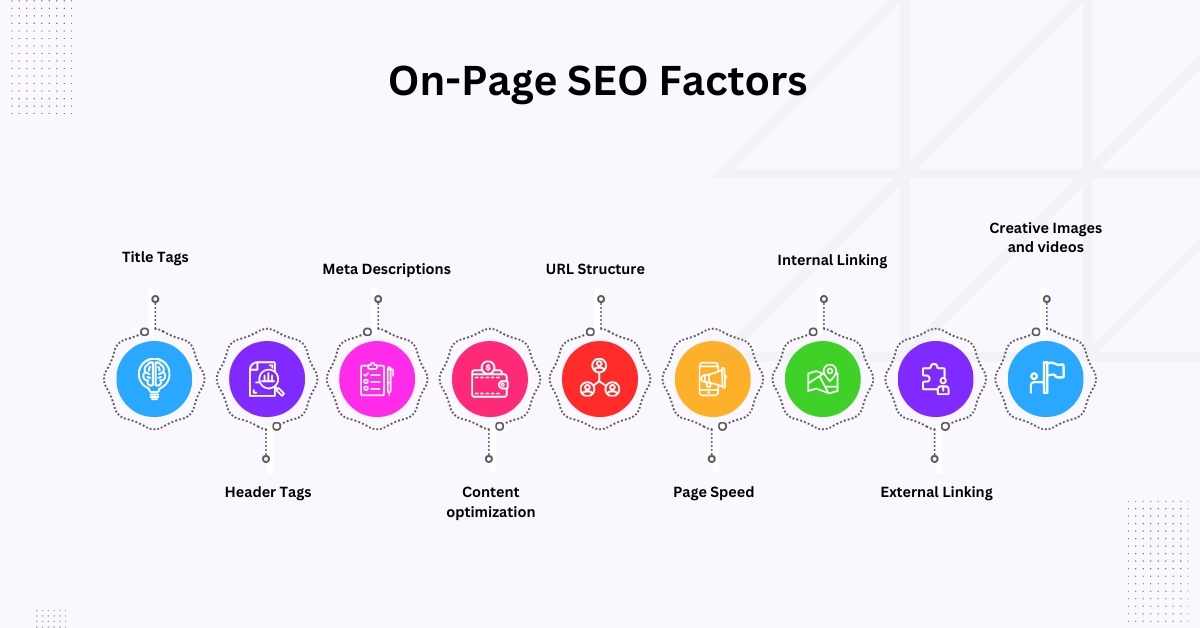
But one thing is clear, AI might be able to string words together coherently, but it can’t replicate the real magic that goes into blogging.
The personal voice, the storytelling flair, the unique insights and experiences that make each writer’s work special – that’s something machines can’t mimic (at least not yet!).
So, you have to be authentic to stand out in this AI-dominated world. As a human, you have the power to connect with readers on a deeper level and capture their emotions.
My rule is to talk with one and send a message to everyone. (Look at my eyes).
So, Here are the Tips that I use in my post:-
- Lean into Authenticity
- Share your unique voice, experiences and perspectives
- Don’t just rehash generic advice – get personal and real
- Embrace Creativity
- Experiment with unconventional formats, styles and angles
- Inject humor, storytelling flair and inspiration from other art forms
- Let your imagination run wild in ways AI can’t
- Prioritize Human Connection
- Write to forge real bonds and resonance with readers
- Tap into shared struggles, dreams and the human experience
- Empathize and speak directly to your audience’s needs
- Stay True to Your Passions
- Infuse your posts with the enthusiasm that comes from real interest
- Don’t just write to hit keywords – write what you deeply care about
- Keep Evolving and Improving
- Consistently hone your skills through practice and feedback
- Study what makes exceptional human writing so compelling
Conclusion
When you create a body of blog posts, Make sure to optimize for both users and search engines. But perfectly nailing every step compounds into content that ranks and converts.
Consistently Creating posts that connect with User’s cravings and satisfy Google’s algorithms is the key to long-term success.
The more you experiment, the more you know what resonates, and the better you’ll become at creating content with anatomy engineered for search dominance.
NOW, turn what you’ve learned into action! Do keyword research, find a topic that needs an authority post, and start creating content poised to attract clicks, links, and rankings.
What’s one blog post anatomy lesson you’ll implement right away? Share your top takeaway below!


